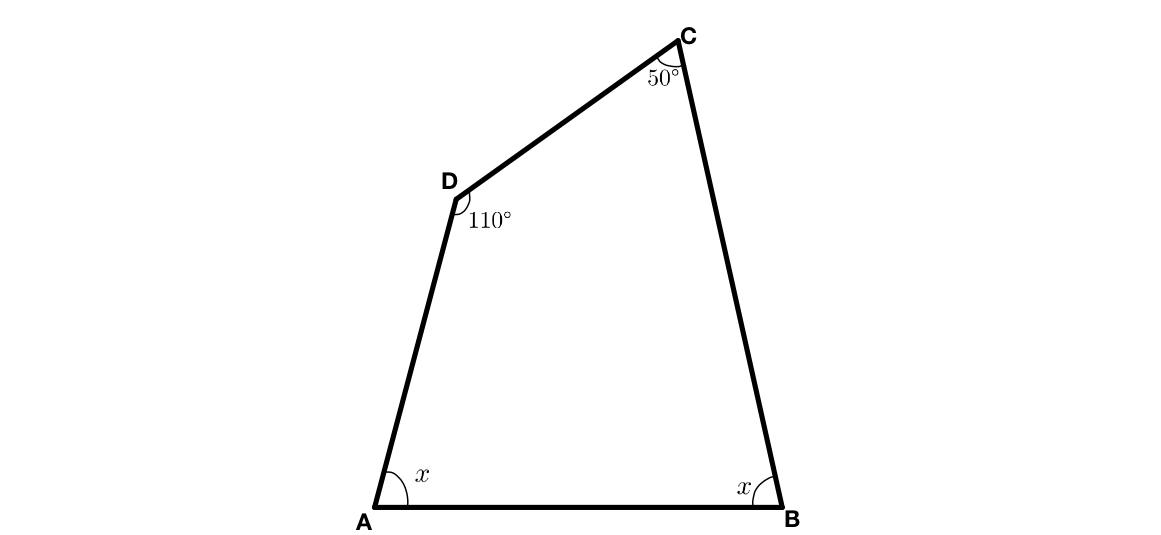
The measure of two adjacent angles of a quadrilateral are $110^{\circ}$ and $50^{\circ}$ and the other two angles are equal. Find the measure of each angle.
Answer
592.2k+ views
Hint: In this question it is given that the measure of two adjacent angles of a quadrilateral are $110^{\circ}$ and $50^{\circ}$ and the other two angles are equal, i.e, $\angle A=\angle B$. We have to find the measures of those angels. So to understand it in better way we have to draw the diagram,

So to find the solution we have to know that the summation of all the angles of a quadrilateral is $360^{\circ}$.
Complete step-by-step solution:
Let ABCD is a quadrilateral, and $$\angle D=110^{\circ}\ and\ \angle C=50^{\circ}$$
Also let $\angle A=\angle B=x$
Now since, the summation of all angles of a quadrilateral is $360^{\circ}$,
Therefore,
$$\angle A+\angle B+\angle C+\angle D=360^{\circ}$$
$$\Rightarrow x+x+110^{\circ}+50^{\circ}=360^{\circ}$$
$$\Rightarrow 2x+160^{\circ}=360^{\circ}$$
$$\Rightarrow 2x=360^{\circ}-160^{\circ}$$
$$\Rightarrow 2x=200^{\circ}$$
$$\Rightarrow x=\dfrac{200^{\circ}}{2}$$
$$\Rightarrow x=100^{\circ}$$
Therefore, the angles are $$\angle A=\angle B=100^{\circ}$$.
Note: In this question it is given that two adjacent angles, so adjacent angles implies two angles when they have a common side. Also for a quadrilateral every angle has only two adjacent angles, like $\angle A$ has two adjacent angles one is $\angle B$ and another one is $\angle D$.

So to find the solution we have to know that the summation of all the angles of a quadrilateral is $360^{\circ}$.
Complete step-by-step solution:
Let ABCD is a quadrilateral, and $$\angle D=110^{\circ}\ and\ \angle C=50^{\circ}$$
Also let $\angle A=\angle B=x$
Now since, the summation of all angles of a quadrilateral is $360^{\circ}$,
Therefore,
$$\angle A+\angle B+\angle C+\angle D=360^{\circ}$$
$$\Rightarrow x+x+110^{\circ}+50^{\circ}=360^{\circ}$$
$$\Rightarrow 2x+160^{\circ}=360^{\circ}$$
$$\Rightarrow 2x=360^{\circ}-160^{\circ}$$
$$\Rightarrow 2x=200^{\circ}$$
$$\Rightarrow x=\dfrac{200^{\circ}}{2}$$
$$\Rightarrow x=100^{\circ}$$
Therefore, the angles are $$\angle A=\angle B=100^{\circ}$$.
Note: In this question it is given that two adjacent angles, so adjacent angles implies two angles when they have a common side. Also for a quadrilateral every angle has only two adjacent angles, like $\angle A$ has two adjacent angles one is $\angle B$ and another one is $\angle D$.
Recently Updated Pages
Master Class 10 General Knowledge: Engaging Questions & Answers for Success

Master Class 10 Science: Engaging Questions & Answers for Success

Master Class 10 Social Science: Engaging Questions & Answers for Success

Master Class 10 Maths: Engaging Questions & Answers for Success

Master Class 10 English: Engaging Questions & Answers for Success

Master Class 10 Computer Science: Engaging Questions & Answers for Success

Trending doubts
Why is there a time difference of about 5 hours between class 10 social science CBSE

Write a letter to the principal requesting him to grant class 10 english CBSE

What is the median of the first 10 natural numbers class 10 maths CBSE

The Equation xxx + 2 is Satisfied when x is Equal to Class 10 Maths

Which of the following does not have a fundamental class 10 physics CBSE

State and prove converse of BPT Basic Proportionality class 10 maths CBSE




